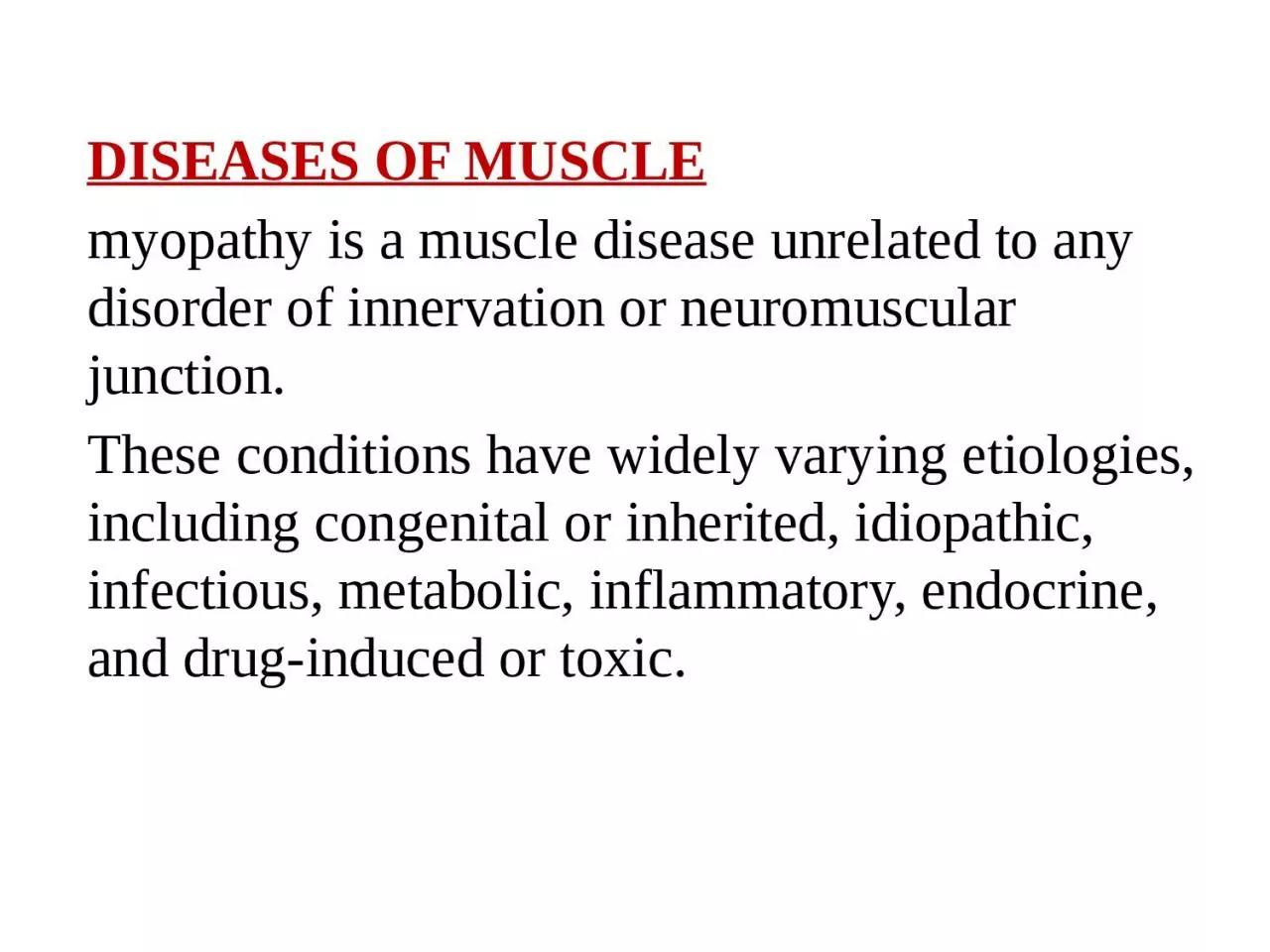

is a muscle disease unrelated to any disorder of innervation or neuromuscular junction These conditions have widely varying etiologies including congenital or inherited idiopathic infectious metabolic inflammatory endocrine and druginduced or ID: 1012368
Download Presentation The PPT/PDF document "DISEASES OF MUSCLE myopathy" is the property of its rightful owner. Permission is granted to download and print the materials on this web site for personal, non-commercial use only, and to display it on your personal computer provided you do not modify the materials and that you retain all copyright notices contained in the materials. By downloading content from our website, you accept the terms of this agreement.
1. DISEASES OF MUSCLEmyopathy is a muscle disease unrelated to any disorder of innervation or neuromuscular junction. These conditions have widely varying etiologies, including congenital or inherited, idiopathic, infectious, metabolic, inflammatory, endocrine, and drug-induced or toxic.
2. CLINCIAL PICTUREProximal, large muscles.Steadily progressive , s.t. episodicSymmetricPreserved tone and tendon reflexesNo sensory\autonomic abnormalityCardiac failure Cardiac conduction abnormalitiesRespiratory problems (sleep apnea)
3. Outline of investigationsCreatine phosphokinase (CK)EMG-NCSMuscle Biopsy (histo-biochemistry)ECGCXRUnderlying cause: Genetic\metabolic screen and counseling Inflammatory/Endocrine/Electrolytes etc..
4. Hereditary myopathiesMuscular dystrophiesMetabolic myopathiesMitochondrial myopathies channelopathy
5. Acquired myopathiesinflammatory myopathies EndocrinologicDrugs and toxins
6. MUSCULAR DYSTROPHIES This is a group of inherited disorders characterised by progressive degeneration of groups of muscles, sometimes with involvement of the heart muscle or conducting tissue, and other parts of the nervous system Myotonic dystrophy (DM1).Duchenne.Becker.Facioscapulohumeral (FSH).Oculopharyngeal.Emery-Dreifuss.
7. Clinical features Onset is often in childhood, although some patients, especially those with myotonic dystrophy, may present as adults. Wasting and weakness are usually symmetrical, no fasciculation , no sensory loss, tendon reflexes are preserved until a late stage, except in myotonic dystrophy. Differential diagnosis is based on the age at onset, the distribution of affected muscles and the pattern of inheritance.Many dystrophies include cardiomyopathy
8. Investigations The diagnosis can be confirmed by specific molecular genetic testing, supplemented with EMG and muscle biopsy if necessary. Creatine kinase is markedly elevated in Duchenne muscular dystrophy, but is normal or only moderately elevated in the other dystrophies. Screening for an associated cardiac abnormality (cardiomyopathy or dysrhythmia) is important.
9. Myotonic dystrophy (DM1)Autosomal dominant.Affect any age.Face (incl. ptosis), sternomastoids, distal limb, generalised later.Myotonia, cognitive dulling, cardiac conduction abnormalities, lens opacities, frontal balding, hypogonadism.
10.
11. DuchenneX-linked; deletions in dystrophin gene.First 5 years.Proximal and limb girdle.Pseudohypertrophy of calves.Cardiomyopathy.
12.
13. Other variants of dystrophinopathy Becker muscular dystrophy :Is a mild form of dystrophinopathy, Patient may live many decades with mild to moderate symptoms.onset usually is after 12 years of age. Progressive weakness of girdle muscles
14. typeDuchenneBeckerOnsetBefore 5 yearsEarly childhood to adultClinical Features Progressive weakness of girdle musclesUnable to walk after age 12 Progressive weakness of girdle musclesAble to walk after age 15 Mental impairment Commonuncommon
15. Facioscapulohumeral (FSH)Autosomal dominant.7-30 years.Face and upper limb girdle.Winging of scapula.
16. Emery-Dreifuss4-5 yearsHumero- peronal, proximal limb girdle laterContractures develop early.Cardiac involvement leads to sudden death
17. CHANNELOPATHIESInherited abnormalities of the sodium, calcium and chloride ion channels in striated muscle produce various syndromes of familial periodic paralysis, Myotonia and malignant hyperthermia
18. Hypokalaemic periodic paralysisa muscle calcium or sodium channel disorderautosomal dominantAttacks are precipitated by a period of exercise followed by rest or by carbohydrate loading. Attacks typically develop in the early hours of the morning and may last hours to days. Serum potassium is typically low at the onset but may normalize quickly. patients with hypokalaemic paralysis will notice improvement with potassium ingestion but worsening with glucose.Thyroid disorder mainly hyperthyroidism can associated with the disease.
19. Hyperkalaemic periodic paralysissodium channel In hyperkalaemic periodic paralysis (hyperPP) patients typically experience recurrent attacks of muscle weaknessPrecipitants include rest following exercise, cold, potassium ingestion or stress. Attacks may vary in severity from mild weakness to total paralysis, The duration of attacks is usually less than 2 hours.Many attacks are brief and do not require treatment. If necessary, acute attacks can be terminated by ingestion of carbohydrate or inhaled salbutamol. Preventative treatment with acetazolamide or a thiazide diuretic may be required.
20. Drug induced myopathyCorticosteroids Chloroquine Amiodarone β-blockers Statins Vincristine Zidovudine Opiates